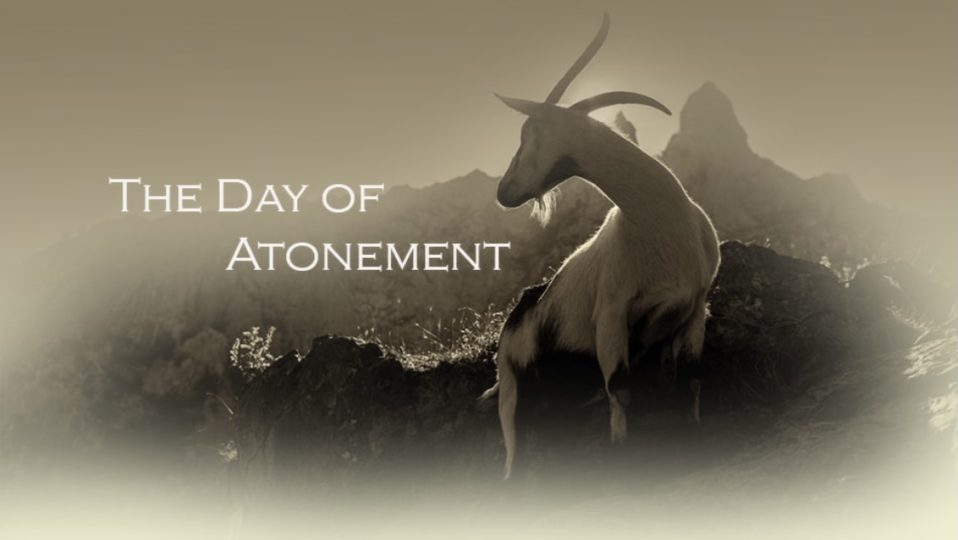The Levitical feast of Yom Kippur (known as the Day of Atonement) starts tonight, September 15, the tenth day of the seventh month (Tishri) of the biblical calendar year. It is the sixth of seven annual Levitical feasts, three of which occur in the fall. Since ancient times the Jewish people have viewed Yom Kippur as the holiest, most important day of the year, foreshadowing events that lead to the close of this age. Yom Kippur bears prophetic significance not only for Israel, but for the Church and all nations.
Yom Kippur occurs ten days after Yom Teruah (Day of Blasting or Feast of Trumpets). Yom Teruah is commonly known as Rosh Hashanah (Head of the Year or New Year). It is a day of sounding the shofar to awaken us to search our souls, repent and prepare for the coming of our King as Judge on Yom Kippur. \1/
Yom Kippur was the singular day of the year on which Israel’s high priest ministered most directly and intimately to YHVH. The Scriptures set forth an elaborate ritual that he was required to meticulously follow. First, he was to cleanse and make atonement for himself and his household. Then he made atonement for the sanctuary of God, and after that, for all Israel. The day long procedure involved ritual washings, wearing special garments, sacrificing animals, and sprinkling blood. (Nu. 29:7-11; Lev. 16) Only on Yom Kippur did the high priest enter the Holy of Holies, specifically to make atonement for it. (Lev. 16:16) As he performed his duties, the Israelites observed Yom Kippur as a Sabbath, praying and fasting in order to “afflict” their “souls” according to Lev. 16:29-31.
By God’s gracious New Covenant, Yeshua’s death and resurrection did what the blood of bulls and goats on Yom Kippur never could. As our high priest, He achieved once-for-all atonement for whoever believes in Him. (Heb. 7:17, 27; 10:4, 12) Then He commissioned His followers, including you and me, to serve as His representative holy priesthood on earth. (1 Peter 2:5, 9) Because Yom Kippur is a day of priestly service, what significance might this day have for us?
Hebrew Meaning of Kippur
The Hebrew word kippur means “covering,” stemming from a root which means to cover. Kippur can also imply the concept of a ransom. Most Bibles, however, do not translate kippur as “covering,” but as “atonement.” The word atonement is derived from the Latin adumanetum, meaning unity. English translators selected it to convey the at-one-ment with God resulting from the covering of sin. In any case, the Day of Atonement is more literally translated Day of Covering, or as written in Leviticus 23:27, “Day of the Coverings”– in plural form.
From the word kippur, it was understood that Israel’s sins were forgiven because they were covered. God took the sins of His people away from them. (Psalm 103:12) As a result the people were able to be at one with Him. Their sins did not, however, cease to exist.
The word atonement is also used in the New Covenant in reference to the sacrifice of Yeshua. (Ro. 5:11) The word is a good one, but can sometimes obscure the difference between forgiveness in the Old and New Testaments. In Messiah, our sins are not merely covered; they cease to exist, entirely. They are thoroughly eliminated! As a Jew who did not always know Yeshua and therefore trembled every Yom Kippur, my soul and spirit now leap on this day for all He has gloriously done. Now on Yom Kippur, I worship God with thanksgiving for His magnificent love, mercy, forgiveness and redemption.
This Yom Kippur, we as a holy priesthood can re-consecrate ourselves to Him with devotional fasting. We can repent of our sins, knowing He is faithful and just to forgive us. We can receive His cleansing anew and recommit to the One who gave His life for ours. We can offer ourselves in worship as living sacrifices, pleasing to Him, rejoicing in praise and gratitude for all He has done. (Ro. 12:1)
Our Priestly Call for At-one-ment
In ancient times, after Israel’s high priest atoned for himself and his household, he made atonement for the sanctuary or house of God. In the New Covenant, the house of God can be seen as the collective people of God rather than a brick and mortar building. In 5782 (2021-22), in response to divisions and disputes about intensifying global shakings, there is a compelling need for a holy priesthood to make at-one-ment for God’s people, His house.
Yeshua prayed for the at-one-ment or unity of His followers before His crucifixion in John 17:20-23: “…May [they] be one as We are one. May they be brought to complete unity to let the world know that You sent Me and have loved them even as You have loved Me.” This prayer is often called His “High Priestly Prayer.” Love based unity of the saints is a, and perhaps even the, priority of Messiah.
Our love for one another is directly related to our love for the Lord. “For whoever does not love their brother and sister, whom they have seen, cannot love God, whom they have not seen.” (1 John 4:20) Without love for our brothers and sisters, we cannot fulfill the greatest command and deep desire of God’s heart: “Love the Lord your God with all your heart and with all your soul and with all your mind. This is the first and greatest commandment.” (Mat. 22:37-38)
This Yom Kippur, in response to challenges to love-based unity faced by God’s people worldwide, there is a call to Yeshua’s holy priesthood to restore at-one-ment in the house of God. On the Day of Coverings 5782, let us “above all, love each other deeply, because love covers over a multitude of sins.” (1 Peter 4:8)
Yom Kippur’s Call to Israel and the Nations
In ancient Israel, the Yom Kippur ritual involved a selection of two goats from the nation’s entire flock. The high priest would cast lots to determine the fate of each goat. \2/ One would serve as a burnt offering for sin and the other, as a scapegoat. The high priest first slaughtered the goat for the burnt offering and sprinkled its blood throughout the sanctuary. Next, he lay his hands on the scapegoat and transferred the nation’s sins onto it. Then he made sure it was taken far away from the people, into a desert wilderness.
The Hebrew word translated “scapegoat” is azazel. It likely derives from a root meaning “to go away” or “be cast out.” In modern Hebrew the name is associated with Satan and the demonic. It is also used as a curse word similar to “damned.”
Together, the two goats of Yom Kippur hint at the ministry of Messiah. Humbly serving as a consummate scapegoat for humankind, Yeshua became a curse for our sake. (Gal. 3:13) Not unlike the goat slaughtered and offered to God, He was slaughtered to atone for our sins. His crucifixion took place with the active consent and supervision of Israel’s high priest. (Mat. 26:57, 65; John 18:28) \3/ This Messianic undertone of Yom Kippur is key to understanding the feast’s full prophetic significance.
In the future, Yom Kippur will be prophetically fulfilled when Yeshua returns and– perhaps partly because of His association with the sacrificial goats of Yom Kippur– Israel recognizes Him as her Messiah. But that is not all. The final Yom Kippur of this age will also be a day of final judgment for all nations. Yeshua may have hinted at this in His parabolic metaphor about sheep and goats.
In Matthew 25:31-46, He warns that He will judge all nations according to their treatment of “these brothers of Mine.” In this context, “brothers of Mine” refers to the Jewish people, His kinsmen according to the flesh. At the end of this age, Yeshua will judge the nations based on how they have treated Israel and the Jewish people. Nations that mistreated the Jews will be cast away from His presence and cursed like the Yom Kippur azazel. Nations that treated the Jews kindly will be gathered to His side and offered to God, reminiscent of the Yom Kippur burnt offering. (Mat. 25:41, 34)
Yeshua will also judge Israel, but pour out on her out a Spirit of grace and supplication so that she will turn to Him and be mercifully saved, to His glory. (Zech. 12:10; Ro. 11:26)
Interestingly, Jewish tradition holds to a similar concept of judgment. God is viewed as a shepherd, causing His flock to pass under His staff every year between Rosh Hashanah and Yom Kippur. He counts and scrutinizes each one, separating them according to their deeds. \4/
If Yom Kippur foreshadows both Israel’s national salvation, and the day of final judgment based on the nations’ treatment of Israel, then we as a holy priesthood are to pray earnestly concerning Israel on Yom Kippur. Foremost, we pray according to God’s heart: “Brothers, my heart’s desire and prayer to God for Israel is that she be saved.” (Ro. 10:1) We also pray for nations to align rightly with Israel according to His Word, that they would be blessed. Their lot depends on it.
May you have a meaningful Yom Kippur and be sealed in God’s book of eternal life.
\1/ Leviticus 23:26 and Numbers 29:7. The intervening ten days are known as the Days of Awe (Yamim Nora’im). According to Jewish tradition that is only indirectly hinted at by a few Scripture verses, heaven’s books are opened on Yom Teruah. It is believed that God inscribes in His books the tentative fate of humankind on that day, deciding who will live and who will die in the coming year. But He does not seal the books until the close of Yom Kippur, giving His people an opportunity to repent and change their fate.
\2/ It is possible to interpret (but not translate precisely) Yom haKippurim in Lev. 23:27 as “Day Because of Lots.” Like the feast of Purim (Lots), certain events on Yom Kippur were determined by the casting of lots.
\3/ Hans Moscicke, “Jesus as Goat of the Day of Atonement in Recent Synoptic Gospels Research”.
\4/ (Mishnah, Rosh Hashanah 1:2, 16a; Unetanneh Tokef).


